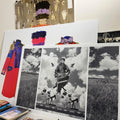A fresh breeze blows through Western Art: Malcolm Myers
By Chadd Scott on
“New old stock” describes old material in new condition. Vintage and pristine.
Pickers use the phrase when finding classic car parts still in the original factory box or baseball card collectors come across unopened packs from 40 or 50 years ago.
Jason Howard made an amazing discovery of new old stock western paintings sorting through Malcolm Myers’ (1917-2002) St. Paul, MN studio. Contained within, secured in a giant flat file under scores of papers, were more than 1500 watercolors depicting cowboys, Native Americans, buffalos, landscapes, horses, and teepees all produced with unique, loose brushwork in a remarkably fresh and vivid palette defying comparison to anything else in the genre.

Malcolm Myers, ‘Untitled #1053 (The Rainbow),’ 1966. Watercolor, black ink on paper; 22.75h x 31w. Courtesy Rubine Red Gallery
“Going through his studio and trying to get everything photographed and catalogued, I ran across the ‘Wild West Series,’” Howard said, adding, remarkably, “and no one's seen it. No one's ever seen it. He never really even showed it to anybody, but there's hundreds and hundreds and hundreds of paintings.”
Howard came to the treasure trove of Myers paintings by happenstance.
Moving to Minneapolis after college, with no background in the arts, Howard began volunteering at a gallery there in the early 2000s. He liked it and thought owning one would be fun in retirement. Not wanting to wait, he opened Rubine Red Gallery in Palm Springs, CA in 2019.
With his background in Minnesota, he represented a handful of painters from the state. At an art show, he met a woman with work on view whose good friend was Malcolm Myers’ widow. Marilyn Myers was coincidentally at the show and an introduction was made.
“I said, ‘hey, I own a couple small pieces of your husband’s work, is there any of it left, I own this art gallery’” Myers recalls. “She was like, ‘yup, I haven’t touched the studio in 20 years since he died.’”
Jackpot.
Howard would go on to manage Malcolm Myers’ estate, going through material for years before coming across the “Wild West Series.”
Malcolm Myers’ West
Myers was born in the Chillicothe-Lucerne, MO area. As a kid he followed his dad to the oil fields of west Texas. McCamey. This was the Great Depression and Myers’ father was looking for work wherever he could find it.
The family would relocate near Wichita, KS in the mid 1930’s. A family friend helped Myers enroll at Wichita State University for Art where he was a top track and field athlete, earning an alternate spot on the 1940 U.S. Olympic team.
Despite eventually spending most of his life in Minneapolis, Myers had a deep affinity for the West, as his “Wild West Series” indicates. During the 1980s, he spent summers in Yellowstone National Park and the Phoenix area.
“He's from the West and he painted western things all of his life, but that ‘Wild West Series’ really was like 1966 through ‘69, that three or four years in there where 95% of these were painted,” Howard explained.

Malcolm Myers, ‘Untitled #1069 (Spotted Horse and Rider),’ 1966. Watercolor, 22.5h x 31w. Courtesy of Rubine Red Gallery.
Malcolm Myers: Printmaker
Myers was considered one of the masters of intaglio printmaking. Intaglio is the overarching term applied to metal-plate printmaking techniques including etching, drypoint, engraving, aquatint, and mezzotint. The word is Italian and translates as “to carve” or “to incise.”
Ink goes into the carved-out groves, opposite of woodblock printing where the raised areas hold the ink that creates the image.
Myers taught printmaking at the University of Minnesota in Minneapolis from 1948 through his death more than 50 years later. His printmaking innovations earned him a pair of Guggenheim Fellowships allowing him to live and work in both Paris and then Mexico City. During the Mexico City period he worked with Diego Rivera. He would also study at the famed Art Students League in New York City as Georgia O’Keeffe, Jackson Pollock and hundreds of other major American artists did.
Myers holds an unusual distinction of being simultaneously remarkably prominent and totally obscure. While his artworks are held in the permanent collections of many of America’s most prestigious art museums – the Los Angeles County Museum of Art, The National Gallery in Washington, D.C., the Smithsonian, the Seattle Art Museum, The Phoenix Art Museum, the Philadelphia Art Museum, the Saint Louis Art Museum – frankly, no one outside of the Minneapolis art community has ever heard of him.
“The slice of the art world where he is most well known and most famous is etching and intaglio. The godfather of American intaglio work is Mauricio Lasansky (1914 –2012) and that's who (Myers) trained under at (University of) Iowa,” Howard explained. “Malcolm was the godfather of (Lasansky’s) kids, so he ran in a highly famous art circle in that little, tiny slice of the art world, and the stuff that's in those museums is all of his intaglio work, it's all of his etchings and printmaking, there's very few paintings, and I know there's no western paintings because, like I said, he painted all these and never showed them ever.”

Malcolm Myers, ‘Untitled #1041 (Proud Rider),’ 1966. Watercolor, 22.5h x 30w. Courtesy Rubine Red Gallery
Malcolm Myers: Painter
Myers may best be known as a printmaker, but his first master’s degree at the University of Iowa following his BFA in Fine Arts there came in watercolor, the medium with which he produced his “Wild West Series.”
The paintings are uniformly sketchy, graphic, narrative and incorporate a full rainbow of colors with plenty of pinks and greens and bold oranges and reds. They feature all kinds of action and movement. Invigorating.
All works from the series were produced on the same kind of paper measuring roughly 22-by-30-inches. In many of them, the image is painted as an oval on the rectangular paper recalling the oval screen of televisions from the 1940s, 50s, and 60s. That was the heyday of the Western TV shows: “The Lone Ranger,” “Gunsmoke,” “Bonanza,” “The Rifleman.”
It’s easy imagining Myers in the late 60s creating his “Wild West Series” taking inspiration both from his personal experiences in the West and the television West, right down to the screen size and shape.
Myers painted a great deal more than the “Wild West Series.” Howard has found success selling his Mid-Century Modern works produced in the 50s and 60s in Palm Springs, a locale defined by the era.
“It's happy. Most of his work makes my clients smile. He did a lot with jazz. He did a lot with animals. He did a lot with Don Quixote and knights in shining armor, but 95% of it isn't dark and dour,” Howard said. “It's lighthearted, but it's good. It doesn't take itself too seriously, but it also isn't comedy, it's not meant to make people laugh, it's just happy art that people really like. The same with the Western paintings, some of this is goofy horses and goofy cows and weird colors of barns; it's interesting because it’s things you normally don't see in Western art.”
Howard also mined Myers’ studio for what might be considered “Western-adjacent” paintings, a category the gallerist has termed “inspired by the West” – farm scenes, a series of canoe paintings perhaps motivated by northern Minnesota’s Boundary Waters, and pictures showing the inside of Myers’ studio. Artworks, along with the “Wild West Series,” Howard is just now introducing to the public for the first time.
A fresh breeze blows through Western art and its source is Malcolm Myers.



